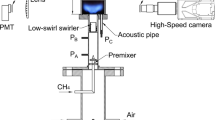Abstract
An analytical study was conducted on the heat release response of a turbulent conical flame to velocity fluctuation considering turbulent flame development. The flame with developing variable flame speed is longer and more oscillatory along the flame front than the flame with constant flame speed. As the flame speed develops more slowly with increasing turbulent time scale, the magnitude of the flame transfer function (FTF) decreases more rapidly with frequency in a more oscillatory manner, and its phase increases more rapidly at low frequencies, approaching to a higher value with increasing frequencies. A linear dependence of the FTF phase upon frequency was observed at low frequencies for variable flame speed, and the gain and the time lag of n-τ model were estimated at low frequencies for various turbulent time scale.
Similar content being viewed by others
Abbreviations
- A :
-
Flame surface area
- f :
-
Frequency
- F :
-
Flame transfer function (FTF)
- Δh R :
-
Heat of reaction per unit mass of mixture
- L f :
-
Flame length
- Q :
-
Heat release rate
- r :
-
Radial coordinate
- r f :
-
Radius of flame front
- R :
-
Radius of premixer
- Sr :
-
Strouhal number
- S L :
-
Laminar flame speed
- S T :
-
Turbulent flame speed
- t :
-
Time
- T :
-
Turbulent time scale
- u, v :
-
Axial and radial flow velocity
- x :
-
Axial coordinate
- β :
-
Flame geometry factor, defined in Eq. (12)
- φ :
-
Phase of FTF
- θ :
-
Half angle of flame
- τ :
-
Time lag
- ω :
-
Angular frequency (= 2πf)
- ξ :
-
Axial flame position
References
T. Lieuwen and V. Yang, Combustion Instabilities in Gas Turbine Engines, AIAA, Inc., Reston (2005).
M. Fleifil, A. M. Annaswamy, Z. A. Ghoniem and A. F. Ghoniem, Response of a laminar premixed flame to flow oscillations: A kinematic model and thermoacoustic instability results, Combust. Flame, 106 (1996) 487–510.
S. Ducruix, D. Durox and S. Candel, Theoretical and experimental determinations of the transfer function of a laminar premixed flame, Proc. Comb. Inst., 28 (2000) 765–773.
T. Schuller, D. Durox and S. Candel, A unified model for the prediction of laminar flame transfer functions: comparisons between conical and V-flame dynamics, Combust. Flame, 134 (2003) 21–34.
Preetham, S. K. Thumuluru, H. Santosh and T. Lieuwen, Linear response of laminar premixed flames to flow oscillations: Unsteady stretch effects, J. Prop. Power, 26 (3) (2010) 524–532.
A. Cuquel, D. Durox and T. Schuller, Theoretical and experimental determination of the flame transfer function of confined premixed conical flames, 7th Mediterranean Combustion Symposium, 11–15 September, Sardinia, Italy (2011).
A. P. Dowling and S. Hubbard, Instability in lean premixed combustors, Proc. Instn. Mech. Engrs., 214 (A) (2000) 317–332.
J. H. Cho and T. Lieuwen, Laminar premixed flame response to equivalence ratio oscillations, Combust. Flame, 140 (2005) 116–129.
D. You, Y. Huang and V. Yang, A generalized model of acoustic response of turbulent premixed flame and its application to gas-turbine combustion instability analysis, Comb. Sci. Tech., 177 (2005) 1109–1150.
K. R. McManus, T. Poinsot and S. Candel, A review of active control of combustion instabilities, Prog. Energy Combust. Sci., 19 (1993) 1–29.
A. N. Lipatnikov and P. Sathiah, Effects of turbulent flame development on thermoacoustic oscillations, Combust. Flame, 142 (2005) 130–139.
G. H. Markstein, Nonsteady Flame Propagation, Pergamon, New York (1964).
P. Palies, T. Schuller, D. Durox and S. Candel, Modeling of premixed swirling flames transfer functions, Proc. Comb. Inst., 33 (2011) 2967–2974.
F. M. White, Fluid Mechanics, 8th ed, McGraw-Hill (2016).
S. Turns, An Introduction to Combustion: Concepts and Applications, 3rd ed., McGraw-Hill (2011).
S. Ravi and E. L. Peterson, Laminar flame speed correlations for pure-hydrogen and high-hydrogen content syngas blends with various diluents, Int. J. Hydrogen Energy, 37 (24) (2012) 19177–19189.
Acknowledgments
This work was supported by the Korea Institute of Energy Technology Evaluation and Planning (KETEP) grant funded by the Korea government Ministry of Trade, Industry and Energy (MOTIE) (Project No.: 20206710100060), and also supported by KIMM’s research funds for gas turbine development.
Author information
Authors and Affiliations
Corresponding author
Additional information
Ju Hyeong Cho received his B.S. and M.S. in Aerospace Engineering from Korea Advanced Institute of Science and Technology (KAIST) in Daejeon, Korea. He received his Ph.D. from Georgia Institute of Technology in USA. Dr. Cho is currently a Principal Researcher at Korea Institute of Machinery and Materials (KIMM) and a Professor at the University of Science and Technology in Daejeon, Korea. His research interests are in the area of design and analysis of gas turbine combustion system with his specialty in thermoacoustic modeling.
Rights and permissions
About this article
Cite this article
Cho, J.H. Modeling of flame transfer function of a conical turbulent premixed flame with variable flame speed. J Mech Sci Technol 36, 6355–6362 (2022). https://doi.org/10.1007/s12206-022-1147-x
Received:
Revised:
Accepted:
Published:
Issue Date:
DOI: https://doi.org/10.1007/s12206-022-1147-x



